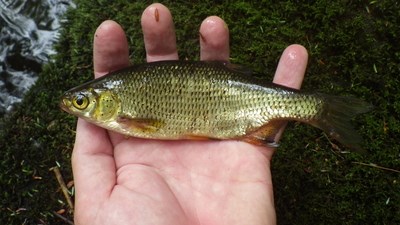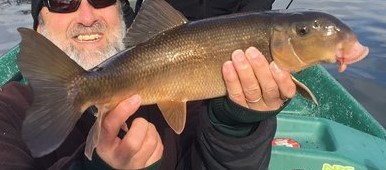Blue-spotted SunfishEnneacanthus gloriosus – Native The Blue-spotted Sunfish is a small fish with a laterally compressed body and bright blue or silver spots along its sides. The Blue-spotted Sunfish prefers slow-moving water and areas with dense submerged aquatic vegetation. Spawning occurs from late spring through summer. Blue-spotted Sunfish are opportunistic feeders, but their diet consists mostly of aquatic insects and other invertebrates. Cutlips MinnowExoglossum maxillingua – Native Eastern MudminnowUmbra pygmaea – Native 
National Park Service FallfishSemotilus corporalis - Native 
National Park Service Golden ShinerNotemigonus crysoleucas - Native The Golden Shiner is a minnow species that inhabits quiet portions of the Upper Delaware River. Golden Shiners prefer areas with clear water and abundant aquatic vegetation. They can grow to be 10 inches and live to about 8 years of age. Females lay adhesive eggs that stick to aquatic vegetation and may produce up to 200,000 eggs multiple times throughout the spawning season. The diet of the Golden Shiner consists primarily of zooplankton and midge pupae. Longnose DaceRhinichthys cataractae – Native Margined MadtomNoturus insignis – Native Tessellated DarterEtheostoma olmstedi – Native 
Evan Padua White SuckerCatostomus commersonii – Native Fishing catch your Fancy?Fishing on the Upper Delaware
|
Last updated: March 27, 2025



